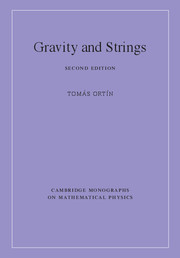Book contents
- Frontmatter
- Dedication
- Contents
- Preface to the second edition
- Preface to the first edition
- Part I Introduction to gravity and supergravity
- 1 Differential geometry
- 2 Symmetries and Noether's theorems
- 3 A perturbative introduction to general relativity
- 4 Action principles for gravity
- 5 Pure N = 1, 2, d = 4 supergravities
- 6 Matter-coupled N = 1, d = 4 supergravity
- 7 Matter-coupled N = 2, d = 4 supergravity
- 8 A generic description of all the N ≥ 2, d = 4 SUEGRAs
- 9 Matter-coupled N = 1, d = 5 supergravity
- 10 Conserved charges in general relativity
- Part II Gravitating Point-Particles
- Part III Gravitating extended objects of string theory
- Appendix A Lie groups, symmetric spaces, and Yang–Mills fields
- Appendix B The irreducible, non-symmetric Riemannian spaces of special holonomy
- Appendix C Miscellanea on the symplectic group
- Appendix D Gamma matrices and spinors
- Appendix E Kähler geometry
- Appendix F Special Kähler geometry
- Appendix G Quaternionic-Kähler geometry
- Appendix H Real special geometry
- Appendix I The generic scalar manifolds of N ≥ 2, d = 4 SUEGRAs
- Appendix J Gauging isometries of non-linear σ-models
- Appendix K n-spheres
- Appendix L Palatini's identity
- Appendix M Conformal rescalings
- Appendix N Connections and curvature components
- Appendix O The harmonic operator on ℝ3 × S1
- References
- Index
7 - Matter-coupled N = 2, d = 4 supergravity
from Part I - Introduction to gravity and supergravity
Published online by Cambridge University Press: 05 April 2015
- Frontmatter
- Dedication
- Contents
- Preface to the second edition
- Preface to the first edition
- Part I Introduction to gravity and supergravity
- 1 Differential geometry
- 2 Symmetries and Noether's theorems
- 3 A perturbative introduction to general relativity
- 4 Action principles for gravity
- 5 Pure N = 1, 2, d = 4 supergravities
- 6 Matter-coupled N = 1, d = 4 supergravity
- 7 Matter-coupled N = 2, d = 4 supergravity
- 8 A generic description of all the N ≥ 2, d = 4 SUEGRAs
- 9 Matter-coupled N = 1, d = 5 supergravity
- 10 Conserved charges in general relativity
- Part II Gravitating Point-Particles
- Part III Gravitating extended objects of string theory
- Appendix A Lie groups, symmetric spaces, and Yang–Mills fields
- Appendix B The irreducible, non-symmetric Riemannian spaces of special holonomy
- Appendix C Miscellanea on the symplectic group
- Appendix D Gamma matrices and spinors
- Appendix E Kähler geometry
- Appendix F Special Kähler geometry
- Appendix G Quaternionic-Kähler geometry
- Appendix H Real special geometry
- Appendix I The generic scalar manifolds of N ≥ 2, d = 4 SUEGRAs
- Appendix J Gauging isometries of non-linear σ-models
- Appendix K n-spheres
- Appendix L Palatini's identity
- Appendix M Conformal rescalings
- Appendix N Connections and curvature components
- Appendix O The harmonic operator on ℝ3 × S1
- References
- Index
Summary
N = 2, d = 4 supergravity is the simplest theory of extended supergravity, and, even though it has no direct phenomenological relevance in particle physics due to the impossibility of reproducing the chiral structure of the standard model, it is a very interesting theory on its own. The increased amount of supersymmetry puts more constraints on possible matter couplings, as compared to the N = 1 case, but these are not completely determined by supersymmetry as in the N > 2 cases. This means that there are many possible N = 2, d = 4 theories with different matter couplings (even for the same matter content). It also means that all these couplings are different realizations of a common and very rich mathematical structure known as special Kähler geometry that governs the couplings of the vector multiplets to supergravity and of another, less interesting, structure known as quaternionic Kähler geometry that governs the coupling of the hypermultiplets (to be defined) to supergravity.
These new structures, which we review in Appendices F and G, emerge from the additional constraints that the second supersymmetry imposes on the Kähler–Hodge geometry that dictates the matter couplings of N = 1 theory. In particular, special Kähler geometry contains information on the symplectic structure present in the couplings between scalars and vector fields in four-dimensional theories (see Section 2.6.2) because N = 2 supersymmetry, unlike N = 1 supersymmetry, constrains the period matrix NΛΣ (defined in Section 2.6.2) that codifies them.
As we will see in subsequent chapters, the couplings allowed by N = 2, d = 4 supersymmetry to the vector super multiplets are just right for having super symmetric charged black-hole solutions with non-trivial scalars, which is impossible in N = 1, d = 4 theories. This makes these theories particularly interesting for us. Furthermore, many (but not all) of them arise from the compactification of type-II theories in Calabi–Yau 3-folds (see e.g. Refs. [111, 583] for a pedagogical introduction), which means that many of the results and solutions obtained in the framework of those N = 2, d = 4 theories can be embedded in full superstring theory.
- Type
- Chapter
- Information
- Gravity and Strings , pp. 220 - 255Publisher: Cambridge University PressPrint publication year: 2015



